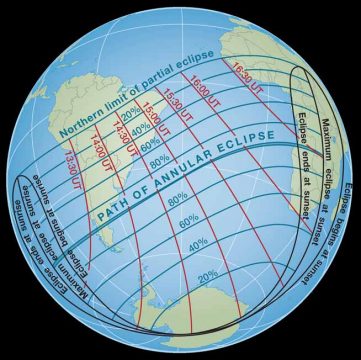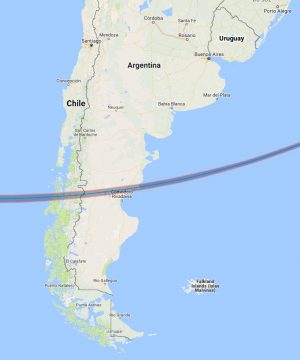Die-hard eclipse chasers journeyed to the Southern Hemisphere to catch a thin "ring" eclipse of the Sun—part of the February annular solar eclipse in 2017!

Sky & Telescope diagram; source: Fred Espenak
Whenever the Moon passes directly in front of the Sun, termed a central solar eclipse, we Earthlings usually conjure up visions of the awe and spectacle of totality.
But that's not always the case. The orbital geometry of the Earth-Moon system is subtle. At this time of year, Earth is relatively close to the Sun in its not-quite-circular obit, so the solar disk appears larger than average. And this coming weekend's new Moon is about midway between its perigee on February 18th and its apogee on March 3rd — so its disk won't be particularly large.
The upshot is that when the Moon and Sun meet in the sky on Sunday, February 26th, the result will be an annular or ring eclipse of the Sun. Astronomers calculate that the magnitude of this annular solar eclipse in 2017—the ratio of the Moon's apparent diameter to the Sun's — is 0.9922. So this event will be very nearly total and only barely annular. It'll be a dramatic sight along the centerline, as the ring at mid-eclipse will be no more than about 15 arcseconds wide!
This geometry also means that the path of annularity—called the antumbra—is very narrow, 31 km (19 miles) wide at the point of greatest eclipse though flaring to as much as 96 km (60 miles) at the endpoints. The culminating ring in this 3¼-hour-long event will last for at most 44 seconds.

Xavier Jubier
The annular solar eclipse in 2017 will be confined almost entirely to the Southern Hemisphere. The path of annularity crosses parts of southern Chile and Argentina, the South Atlantic Ocean (where mid-eclipse occurs at 14:53 Universal Time), Angola, and (at sunset) the Zambia-Congo border.
Partial phases of the annular solar eclipse in 2017 sweep over most of South America, Africa, and Antarctica, as the globe above shows. North Americans are left out entirely.
According to meteorologist Jay Anderson, the weather prospects in Africa are relatively poor. But they're much better in South America and especially over the flat Patagonian plains of southern Argentina, where the likelihood of a cloud-free morning is 60% or better. Not surprisingly, that's where most eclipse-chasers are headed.
So wish them all clear skies—and let's hope they take plenty of dramatic images of this celestial treat.
Check out Fred Espenak's website for more details.
 5
5









Comments
February 24, 2017 at 9:47 pm
This site will be streaming the eclipse beginning at 12:10 UTC* Feb 26:
https://www.timeanddate.com/live/
* ( 4:10am PT, 7:10am ET)
You must be logged in to post a comment.
Sadiesadie81
February 26, 2017 at 12:22 am
What is the central time in the US
You must be logged in to post a comment.
February 24, 2017 at 9:56 pm
SLOOH will also be streaming it live beginning at 7am Eastern Time - link:
http://live.slooh.com/stadium/live/the-southern-ring-of-fire-solar-eclipse
You must be logged in to post a comment.
Bob
February 26, 2017 at 8:27 am
Misha17...
Thanks for posting the two live links of today's Annular Solar Eclipse. Both links are very interesting.
Bob Patrick
Kentucky
USA
You must be logged in to post a comment.
Graham-Wolf
February 26, 2017 at 8:01 pm
Sadly..... NOT visible from NZ, Kelly.
Nor the "total" later this year.
You folk go hard, and nail it for us!
Looking forward to reading the results and seeing the pics in S&T.
Already quite busy with 45p, 41p, 73p. That's quite a nice handful.
Regards from 46 South NZ.
Graham W. Wolf.
You must be logged in to post a comment.
You must be logged in to post a comment.